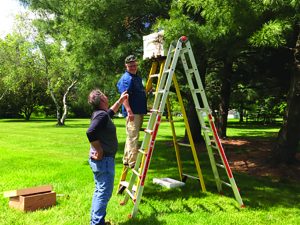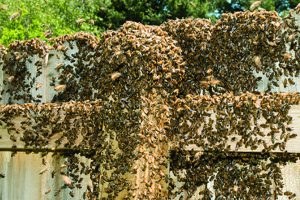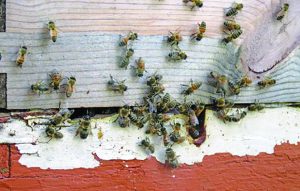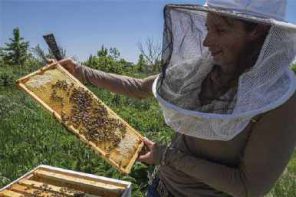By: James Tew
Most swarms come with a story.
When does swarming look like robbing?
Unhappy bees at the beach.
For The Brand New Beekeepers – It’s not impossible for a
new package to swarm.
Swarms usually come with a story
The Dale Swarm
The father of a friend had died. We were dressed and on our way to his calling hours to express our sympathy. It’s not like I was dressed for a formal wedding, but rest assured, I was not dressed for beekeeping. As we left our home and headed for the car – there they were – thousands of them – an unsettled swarm in flight.
There is always a brief moment before an idea or a realization is formed, at least for me anyway. Does anyone else have that “fleeting moment” experience? For the briefest of moments, I felt puzzlement – what is that? Cicadas? Leaves? And then the slam comes – that’s a swarm! Beekeepers, you know the rules. It’s a swarm, and like Superman, we must do what we must. We have to try to hive it.
I was unprepared for the surprise of a swarm – again. I dashed to my shop to find any equipment that was there. To make the walk to my equipment storage barn would take more time than I had. Happily, I had a new plastic foam nuc that I had recently purchased. With a few frames – each having problems that I had been photographing – I improvised a catch box. Actually, it was a good one.
My wife exploded into the shop saying that there was a swarm in the air. I barely had time to talk. As those who have read some of my previous swarm stories, know that I have either lost swarms outright or had them pitch so high as to be unreachable. I hoped that I could do something to keep these bees low (enough). This swarm seemed to be landing about 12 feet from the ground. I set up two ladders and began the process of shaking and disrupting the settling cluster hoping some roaming bee would find my enticing bee box. You know the scene – bees everywhere – chaos. (Yet in all this biological bedlam, I had the thought, “Possibly we could attend the funeral tomorrow and miss the calling hours today.” Don’t forget, I was on my way to a formal event. Surely all beekeepers and funeral-goers would understand.)
I had done a pretty good job of relocating the cluster, but it was mingled with tree limbs, two ladders, and me wearing impractical clothes. It was at this point, that my neighbor – who is not a beekeeper at all – asked if he could help. I had no idea he was at the scene, so I was completely surprised. The bees had been perfectly gentle. No stings. I had not taken time for protective gear. What should I do for my neighbor while in the middle of a swarm and on my way to a calling hours? It’s one of those situations – do you tell him “no” and ask him to move back? (For any long time readers, I have referred to my neighbors in the past. I have had swarms land in his yard. My bees have been at his humming bird feeder and at his birdbath. Through the years, my neighbors have tolerated a lot from me and my bees. I absolutely could not be rude.) I told him I could use help setting the box on the ground. He helped. Nothing happened and he appeared to absolutely love the experience. Happily, my wife had the presence of mind to photograph all of this with her cell phone.
To designate the swarm, I named it the “Dale Swarm” after my neighbor. I made it to calling hours only a few minutes late, a bit winded, with a few bee poop spots on my shirt, and one unusual story.
Afterwards, I moved the swarm to my apiary. Two days later, I found the queen. I will replace her later this Summer. Compared to so many others, so far, this swarm story has had a happy ending. I love happy endings.
The poop swarm
You have no reason to know that I have serious hearing loss. I wear hearing aids that make my serious hearing loss only “somewhat” serious. Essentially, I do not hear well.
I take frequent trips to my home apiary for no other reason than I simply want to make the walk. A few days after the Dale Swarm event, I did that very thing. As I approached the apiary with my poor hearing, even I could hear the happy foraging sounds of eager bees. I had the thought that these bees were really foraging. All was good. Once inside my fence (I wrote about the fence installation, too.), the bees from all hives were crazy active. I relished the contribution that my bees and I were making to my local ecosystem.
As I strolled, in front of one hive – on the ground – was a queen. Her wings were stuck together with wet bee poop. It was the strangest thing I have even seen from a queen. I put in her in a queen cage and placed her at the entrance of several colonies, but no bees gave her the slightest interest (Sadly, so sadly I did not photo the bee-poop queen. My bad.) At this instance, please review my comment above about the mental confusion just before an idea arrives.
Wait a minute – all that foraging sound – was that truly only foraging noise from all these hives? I moved from beneath the apple tree canopy and away from the blue spruces that surround my beeyard and looked up. There were thousands of bees in the air. Could it be that the poop queen was theirs? Where to put her? Where to put her? Think fast. Where is a good photographic spot? I placed her atop one of the fence posts and waited. Within three minutes, the bees began to settle around her. I literally spent the remainder of the afternoon photographing and videoing the swarm as it settled, and as I moved it into a five-frame nuc. The poop swarm was a unique event for me.
I still have the poop swarm. It is an established colony and seems to have settled into my hive equipment. The queen was quickly made all nice and clean.
One final point is that I may have been very lucky with this swarm. Though bees quickly found the caged queen, they took quite a bit of time settling on the fence. When I moved the caged queen to the nuc box, only a few hundred bees went with her. The others took to the sky in an area that I estimate to be about 3/4’s of a football field. The swarm really scattered. After a short hour, the swarm finally returned to the nuc box. I strongly suspect that they had another site selected, and it was not my nuc box. I think I lucked out with this one. But really, isn’t that the case with all swarms?
When does swarming behavior look like robbing behavior?
The Free Bee Swarm
I was still feeling good about my bee swarm fortune. I checked them on a daily basis for a week to be sure they had not left. On one of my apiary walks, I noticed that some unused equipment was being robbed. In past articles I had wondered if robbing behavior could be used as an indicator of the absence of a nectar flow. When making splits or raising queens, knowing when to expect robbing behavior to start would be helpful.
I watched the robbers come and go. They did not seem crazy frantic as robbers normally are. That’s puzzling. My thoughts flitted back to the robbing-as-a-management-tool idea. Maybe just lay a partially filled frame out in the open. Would some of the foragers visit this source? Is there any real difference between robbers and foragers? I didn’t and still don’t have a lot of answers.
Meanwhile back at the equipment that was being robbed, there were a few bees scenting. Why would robber bees scent? That would only increase competition for the scant food supply. A thought was trying to form. I was in the fuzzy phase. While my mind was on robbing behavior, this equipment was apparently being raided. Increasingly, things didn’t look normal. When a couple of drones alit near the entrance, my fuzzy phase ended! That’s not robbing. The bees are too calm, workers do not scent at the robbing site, and drones play no part in robbing. This has to be a swarm that had moved into my unused equipment. That’s not uncommon, but it has not happened to me in many years.
I suited up and ripped into it. A stack of six deep supers had disorganized bees scattered throughout the equipment. There was no cluster – at least not at the moment. I had no idea where the queen would be. Apparently, the swarm had only been settling for a short time; so, leave it alone or do something? You know I could not leave it alone.
I went through four deeps and shook as many bees as possible into the bottom two deeps. I closed the two deeps up and waited to see what the bees did. They began to scent. I used my leaf blower to blow the remaining bees from the four deeps referred to earlier. I closed these now mostly empty deeps, but left a small opening for any remaining bees to escape or for the swarm to return to them should the queen still be in them. While there was some confusion, the bees were clearly accepting the two deeps as I had hoped.
I was not expecting yet another swarm. This was a pleasant surprise. As it were, these were free bees. For discussion, this is the “Free Bee” swarm.
The comb swarm
Yet a few days later on yet another apiary walkabout, I noted “robbers” again. This time had to be for real – right? If there were a dearth, it would be a good time to explore using robbers as a nectar flow gauge. I opened the extra equipment from some of last Winter’s dead colonies to search for a partial frame of old honey. Immediately upon opening the equipment, I saw entirely too many bees to be robbers and a medium piece of burr comb hanging in an empty frame space. Robbers do not build combs – they destroy it. I suppose I was somewhat expecting it this time. This was a nice swarm, and my abrupt opening required that I quickly stop everything for some personal protective gear.
I was once again happy to see yet another swarm had settled in. I cannot believe these are all from my bees, but whatever . . . I am certainly glad to get them.
I did simply lay out a comb to monitor robber/foraging activity on an exposed food source. I had a look the next day only to find that the raccoons had left me a thank you note. The frame was completely cleaned and was laying several yards away. Back to the drawing board on that idea.
This has been a great year for colony buildup and for swarm retrieval. It feels good not to be composing another of my complaining articles.
Unhappy bees at the beach
My extended family and I recently vacationed at one of the Florida panhandle beaches. We had a perfectly wonderful experience. The beekeepers who introduced me to this particular beach and helped me set the trip up know who you are – a sincere thanks to you.
It was supposed to just be a non-bee beach trip. That just could not happen. I found a nearby commercial bee yard with a heavy-duty bear fence around it, and photographed it. But more interestingly, my son-in-law, Doug, commented that he had seen a dead bee washed up on the beach. This was interesting, but I had no other thought – until I saw a bee washed up on the beach. Okay. There is little explanation for this. Late in the afternoon, I took a walk and counted about 30 bees – none alive – during about an eighth of a mile walk. Over the next three days, I found 50-55 (total) bees – nearly all in the later afternoon-in other approximately 1/8th mile walks.
While I never saw a water forager, I finally found one lone bee that was alive – if you could call it that. It was manically spinning on the sand at full speed – rarely stopping. Members of my non-beekeeping family said it was the strangest thing they had ever seen.
I only have a short bit of bad video, but I have posted it at:
Shortened URL is at:
I have precious little science on this subject. I don’t know why the bees were along this beach. I really don’t even have much of a guess. It could be anything and is probably a fluke. I simply don’t know what is happening. Do you?
Senior Citizen Beekeeping
Last month, I wrote that I would continue this thread this month. However, that did not leave any of you who have Senior Citizen beekeeping experience any time to comment. Maybe you will and maybe you won’t. At any rate, I would like to wait at least a month to see if any of you beekeepers who are long on experience have had some successes. I will follow up on this subject. Senior Citizen beekeepers, let me know what you do to make your beekeeping possible.
For the brand new beekeeper
All you new beekeepers who purchased packages last Spring, if all went well and there was a good nectar flow, you will need to provide space for that new queen to work out. While it does not happen all the time, it is not impossible for package bees to build up, become crowded and cast a late season swarm. Such swarms generally have little chance for surviving the Winter. It is normally better to give too much space than too little. We all have good intentions but you need to give these new packages space.
Thanks for reading. Good luck with your beekeeping.
Dr. James E. Tew, State Specialist, Beekeeping, The Alabama Cooperative Extension System, Auburn University; Emeritus Faculty, The Ohio State University. Tewbee2@gmail.com; http://www.onetew.com; One Tew Bee RSS Feed (www.onetew.com/feed/); http://www.facebook.com/tewbee2; @onetewbee Youtube: https://www.youtube.com/user/onetewbee/videos















